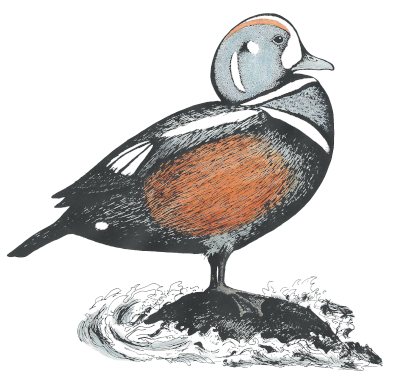
Pinaceae - pine family
Leaves. Pinaceae leaves, often called needles, occur singly in a spiral-like fashion around the twig (Abies, Picea, and Tsuga) or in clusters (Larix and Pinus) of various numbers. The white lines of dots on the underside of a leaf are rows of stomata (singular: stoma), the location where gas exchange takes place during the process of photosynthesis. With the exception of the leaves of Larix, which are annually deciduous, the leaves of the rest of Maine’s species in the pine family remain on the twig for more than one year.
Cones. In the Pinaceae, there are two kinds of cones: the woody seed cones that are familiar to most people (although not usually identified to species by the casual observer), and pollen cones, known indirectly to many through the yellow pollen that is found on cars and on the margin of puddles in the springtime. Unlike seed cones, pollen cones grow in clusters, often more than a dozen together. Also unlike the woody seed cones that remain on the tree for sometimes several years, pollen cones are relatively soft and by mid-summer have fallen to the ground.
Maine is home to 15 species in 5 genera (hybrids excluded). If you know which species you have or are interested in learning about, click on the appropriate link from the species list below. Otherwise, to determine which genus your plant belongs to, refer to the table below the species list.
Abies (2 species)
Abies balsamea - balsam fir
Abies concolor - white fir
Larix (2 species)
Larix decidua - European larch
Larix laricina - American larch, hackmatack, tamarack
Picea (4 species)
Picea abies - Norway spruce
Picea glauca - white spruce
Picea mariana - black spruce
Picea rubens - red spruce
Pinus (6 species)
Pinus banksiana - jack pine
Pinus nigra - Austrian pine
Pinus resinosa - red pine
Pinus rigida - pitch pine
Pinus strobus - eastern white pine
Pinus sylvestris - Scotch pine
Tsuga (1 species)
Tsuga canadensis - eastern hemlock
| red font = character state unique or nearly so | needle/leaf occurrence | base of needle/leaf | tip of needle/leaf | seed cone orientation on a branch | umbo on seed cone |
| Abies | singly | expanded, leaving a round scar on twig | often indented | erect | absent |
| Larix | clusters of approximately 8 or more | n/a | pointed but not sharp | pendulous | absent |
| Picea | singly | attached directly to a sterigma (“peg”) that diverges from the twig | pointed, noticeably sharp | pendulous | absent |
| Pinus | clusters (fascicles) of 2, 3, or 5 | n/a | pointed by not sharp | pendulous | present |
| Tsuga canadensis | singly | attached by a thin petiole to a sterigma (“peg”) that diverges from the twig | pointed but not sharp | pendulous | absent |
Abies (fir)
[information to be added]
| char. 1 | char. 2 | char. 3 | char. 4 | char. 5 | |
| A. balsamea | |||||
| A. concolor |
Abies balsamea (balsam fir) is most easily identified by noting the expanded base of each leaf. The branching pattern of balsam fir twigs is quite symmetrical, unlike that of eastern hemlock. Many people think that the leaves of a balsam fir branch lay in one plane, and that is generally true of trees that grow in more or less shaded areas of low elevation (image below left). However, in exposed and/or higher elevation sites, the leaves often curve noticeably and can be mistaken for those of spruce if one does not look carefully (image below center).The seed cones of Abies balsamea grow erect on branches (image below right) vs. pendulous for other members of the Pinaceae, and they release their seeds when the cone scales separate from the cone axis vs. other Pinaceae cones, which remain intact.
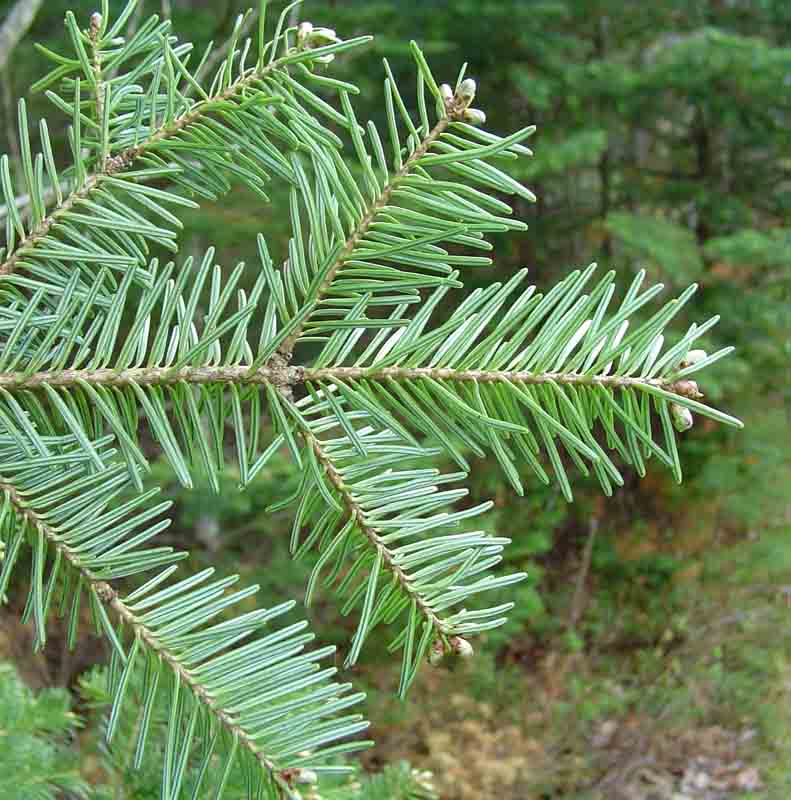
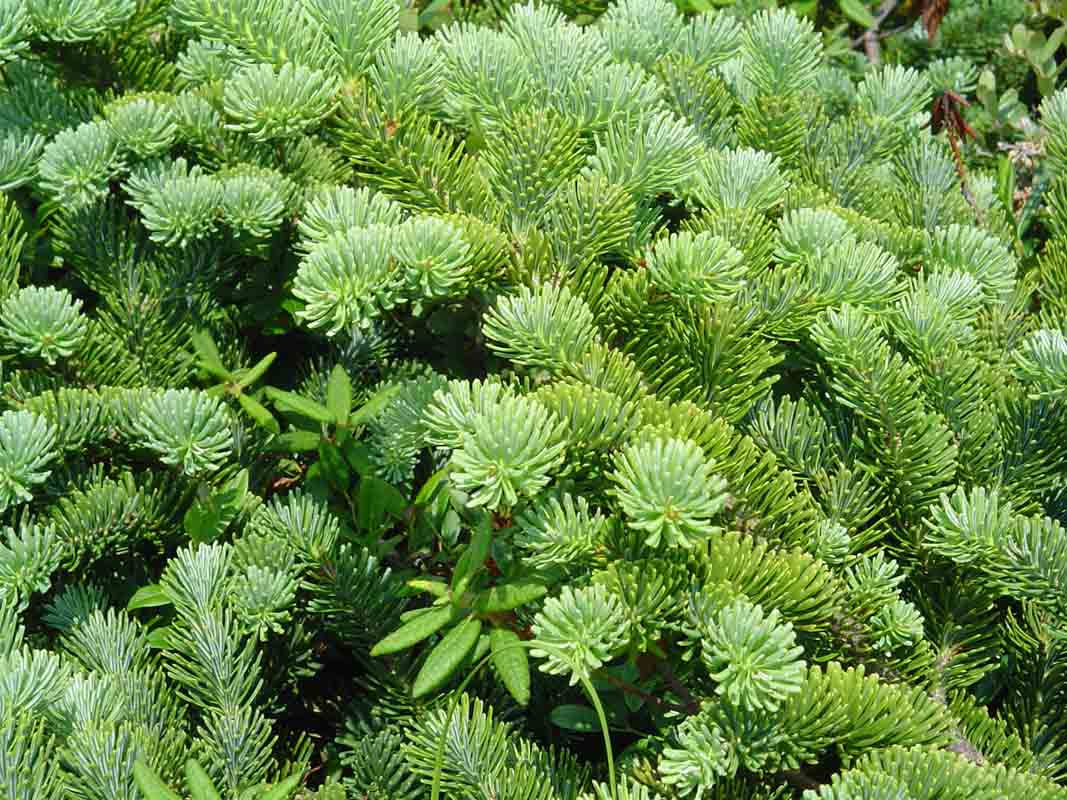
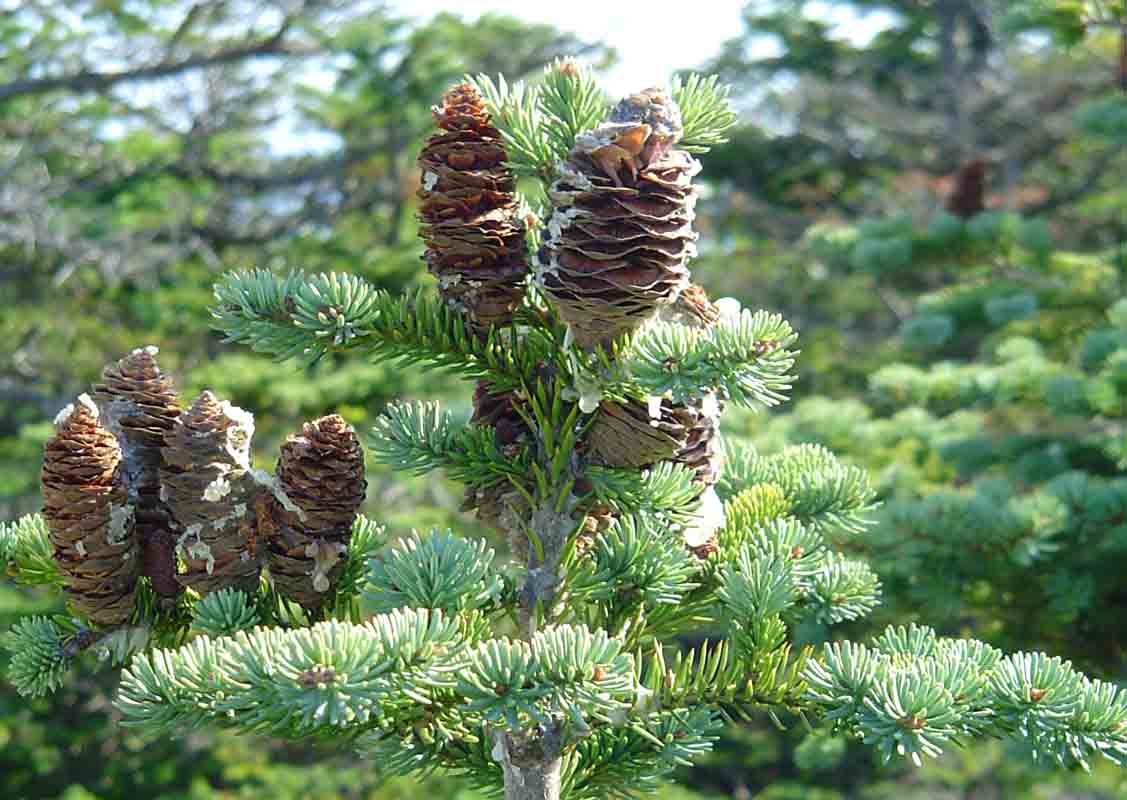
(click on an image to enlarge)
The seed cones of Abies balsamea grow erect on branches (vs. pendulous for other members of the Pinaceae) and release their seeds when the cone scales separate from the cone axis (vs. other Pinaceae cones, which remain intact). A good place to see balsam fir seed cones is on the top of Cadillac Mountain along the path leading from near the gift shop to the south ridge trail.
(click on image to enlarge)
Abies concolor (white fir) - [information to be added]
Larix (American larch, hackmatack, tamarack)
[information to be added]
| char. 1 | char. 2 | char. 3 | char. 4 | char. 5 | |
| L. decidua | |||||
| L. laricina |
Larix decidua (European larch) - [information to be added]
Larix laricina (American larch, hackmatack, or tamarack), a species with fascicles of eight or more leaves (image of emerging leaves below), is Maine’s only deciduous conifer (i.e., American larch loses all of its leaves each fall).
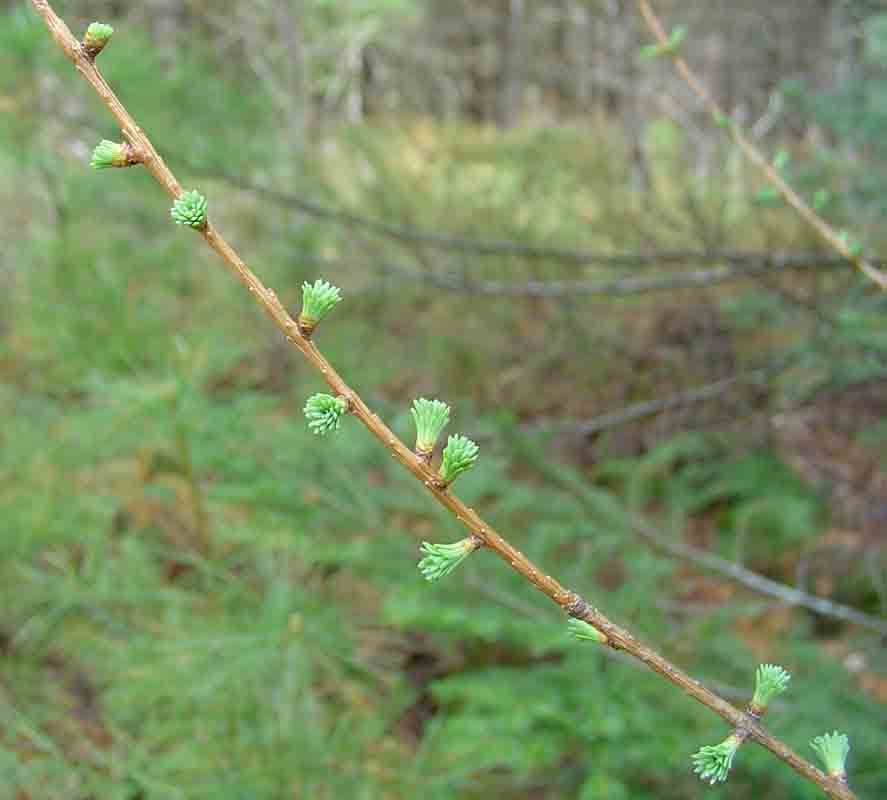
(click on image to enlarge)
Picea (spruce)
As mentioned near the top of this page, Picea leaves are attached to short peg-like projections called sterigmata (image below). At the base of each sterigma is an angle that forms an imaginary dividing point between the sterigma that diverges from the twig and the twig ridge that runs lengthwise along the twig for a short distance. The presence or absence of very short hairs on the twig and the shape of the twig ridges are important features used in identifying the species.
Twigs of white spruce (P. glauca) are completely devoid of hairs; both black spruce (P. mariana) and red spruce (P. rubens) have few to many hairs on the twig. Differentiating between black and red spruce is more problematic, and it is thought that there may be hybridization between them or even that they may not be distinct species. The amount of rounding of the cross-section of the twig ridges, called “twig ridge inflation”, is often used to differentiate red and black spruce (when each is thought to be a valid species). Red spruce has very rounded cross-sections of twig ridges. (Imagine a hot dog cut lengthwise and then one of those pieces laid with the cut side touching the twig.) Black spruce has a flat twig ridge cross-section. (Imagine if the twig ridge had been filled with air and was then deflated with a pin prick.) There are varying degrees of “inflation”, one factor leading to a hypothesis of hybridization.
| red font = character state unique or nearly so | twig hairs | twig ridge inflation |
| P. abies | ||
| P. glauca | absent | inflated/convex |
| P. mariana | present, sometimes tipped with a gland | flat |
| P. rubens | present | inflated/convex |
Picea abies (Norway spruce) - [information to be added]
Picea glauca is sometimes called cat spruce because a bruised twig can smell distinctly [di-stink-tly?] like a cat box. Some trees have a stronger odor than others, but for any given tree, in spite of its smell, a fair number of people seem unable to detect the smell.
Twigs of Picea glauca are devoid of hairs and are noticeably thicker than the twigs of other native Maine Picea (image at left), a feature that one can recognize with a little experience.
The seed cones of Picea glauca (image at lower right) are much longer relative to their width than those of P. mariana or P. rubens.
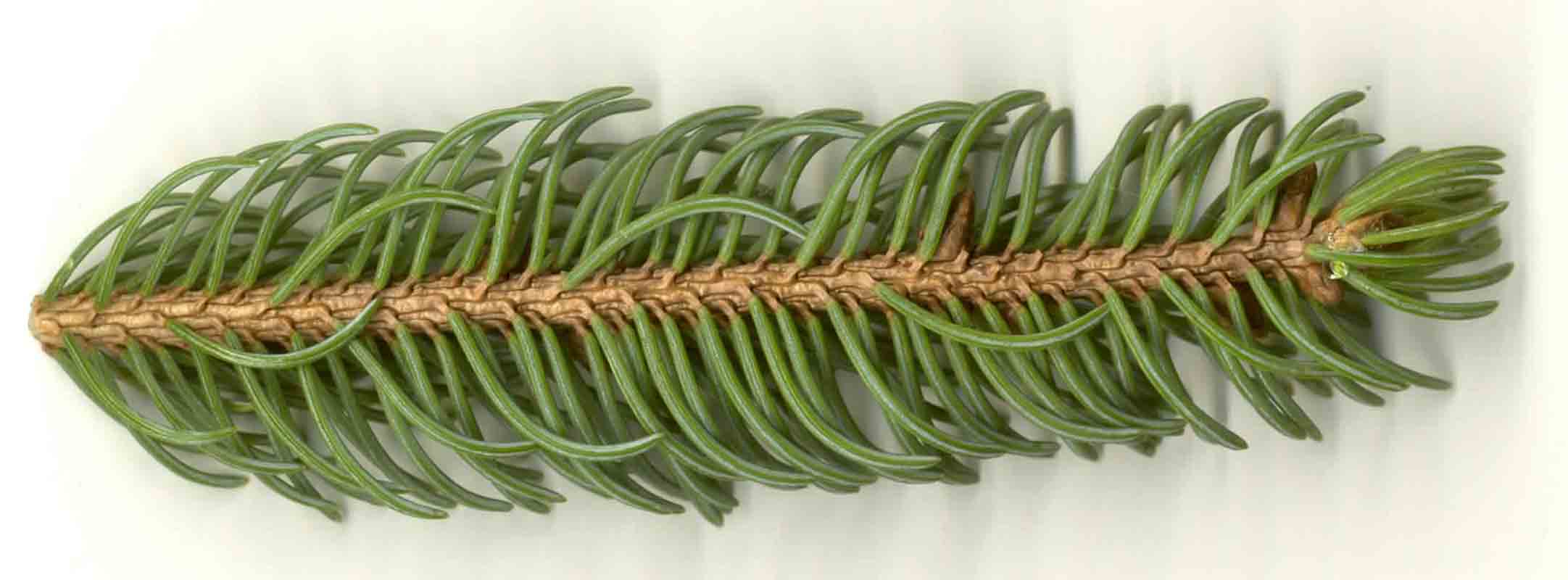
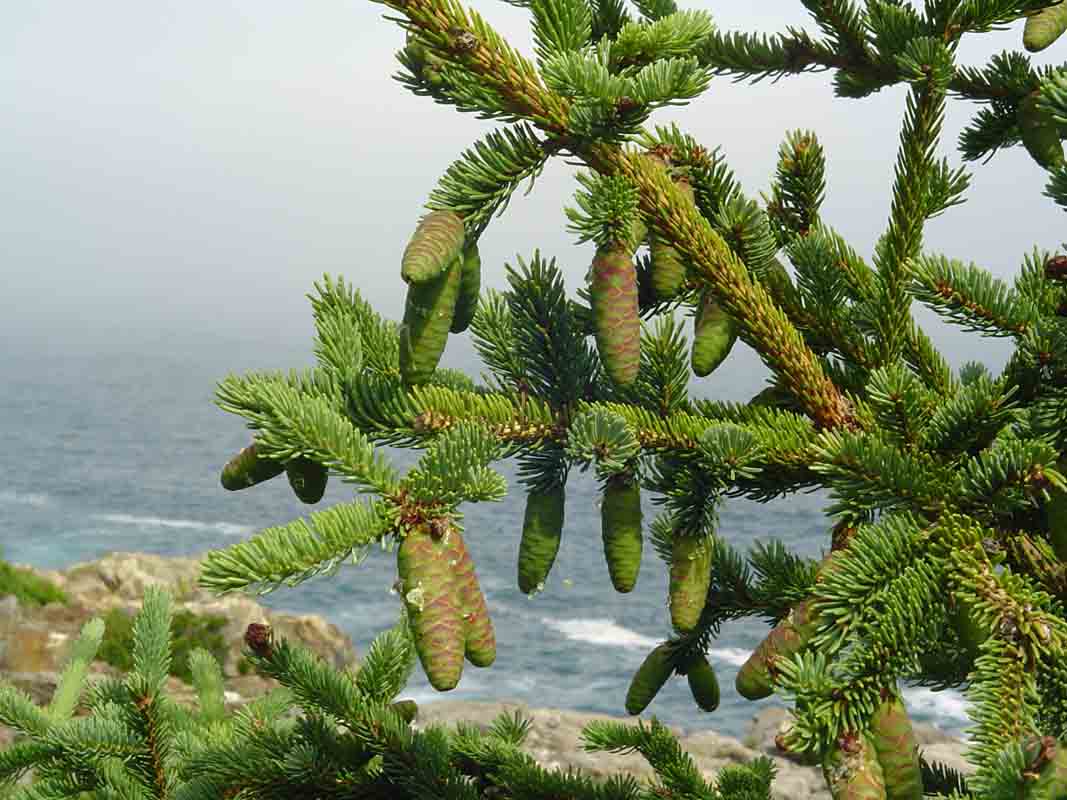
(click on an image to enlarge)
Picea mariana (black spruce) is the common spruce species found in a heath, as in the image below.
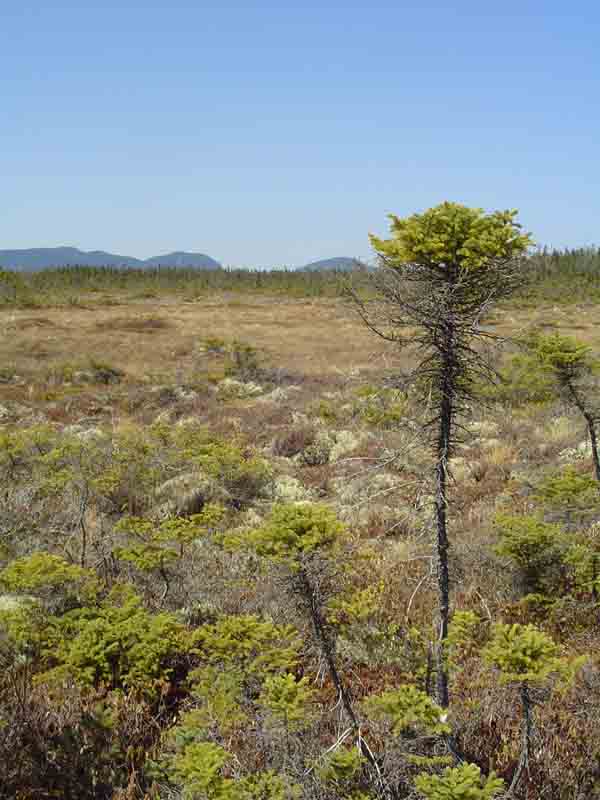
(click on image to enlarge)
Picea rubens (red spruce). The hairs on the twig (image below left) and the “inflated” twig ridges (same image) distinguish red spruce from the other two Picea species in Maine.
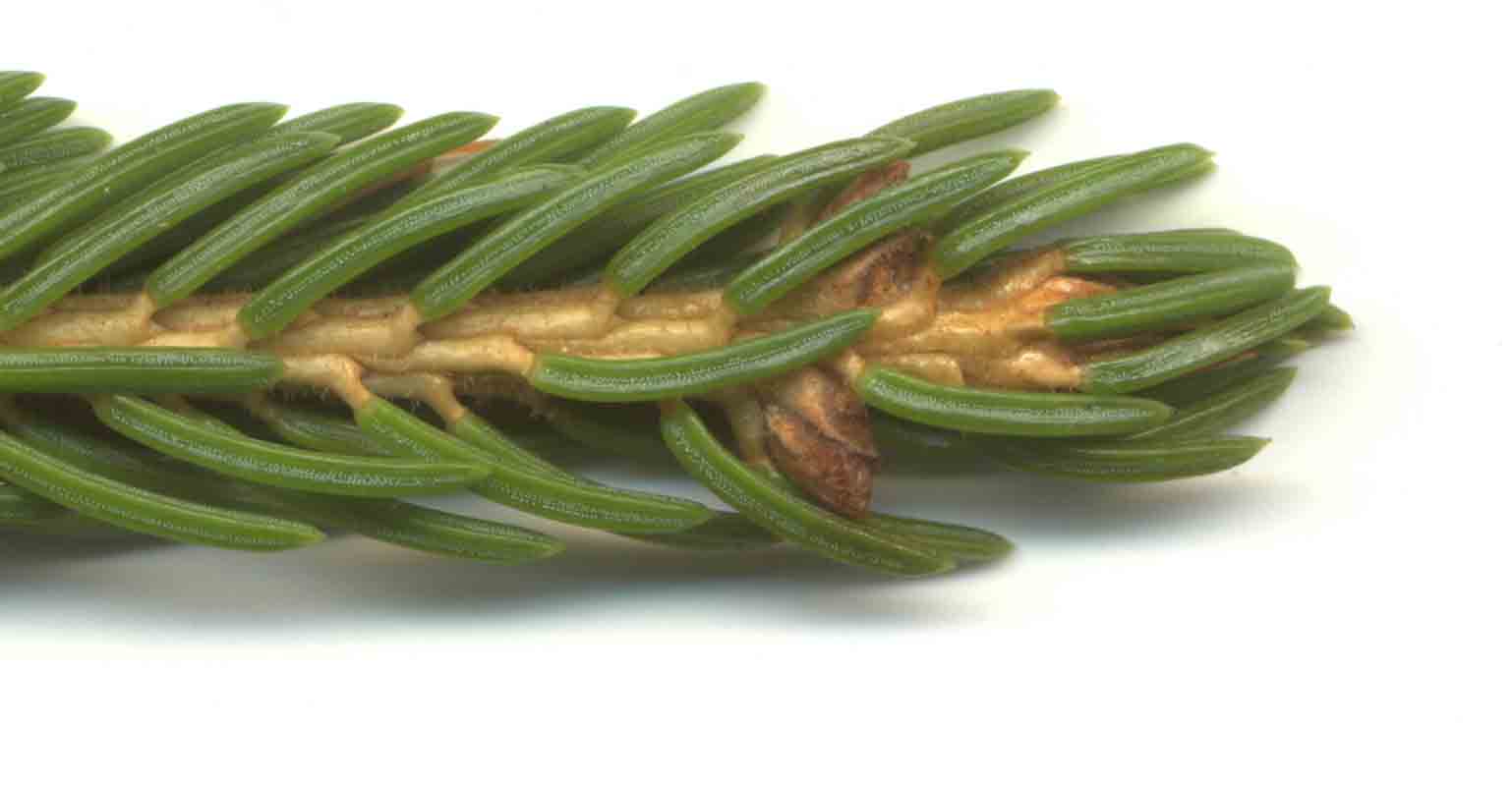

(click on an image to enlarge)
Pinus (pine)
Seed cones of pine trees, often simply referred to as “pine cones”, differ from those of the other genera in the pine family by having scales with a thickened portion, called an umbo, at (Pinus strobus, eastern white pine) or near (the remaining species) their tips. (Note: please do not make the mistake of applying the term “pine cone” to the seed cones of all genera in the pine family. I once heard someone point out the “pine cones on the ground under the spruce trees”!)
| red font = character state unique or nearly so | young bark color | number of needles/leaves in a fascicle | needle/leaf length | position of umbo on cone scale |
| P. banksiana | gray-brown | 2 | 2–4 cm | dorsal |
| P. nigra | 2 | dorsal | ||
| P. resinosa | gray-brown | 2 | 7–16 cm | dorsal |
| P. rigida | gray-brown | 3 | 3.5–14 cm | dorsal |
| P. strobus | gray-brown | 5 | 6–13 cm | terminal |
| P. sylvestris | salmon-orange | 2 | 3–7 cm | dorsal |
Pinus banksiana (jack pine) has fascicles (clusters) of two short leaves (needles) and seed cones that are often slightly curved. As in other species of Pinus, the pollen cones are clustered.
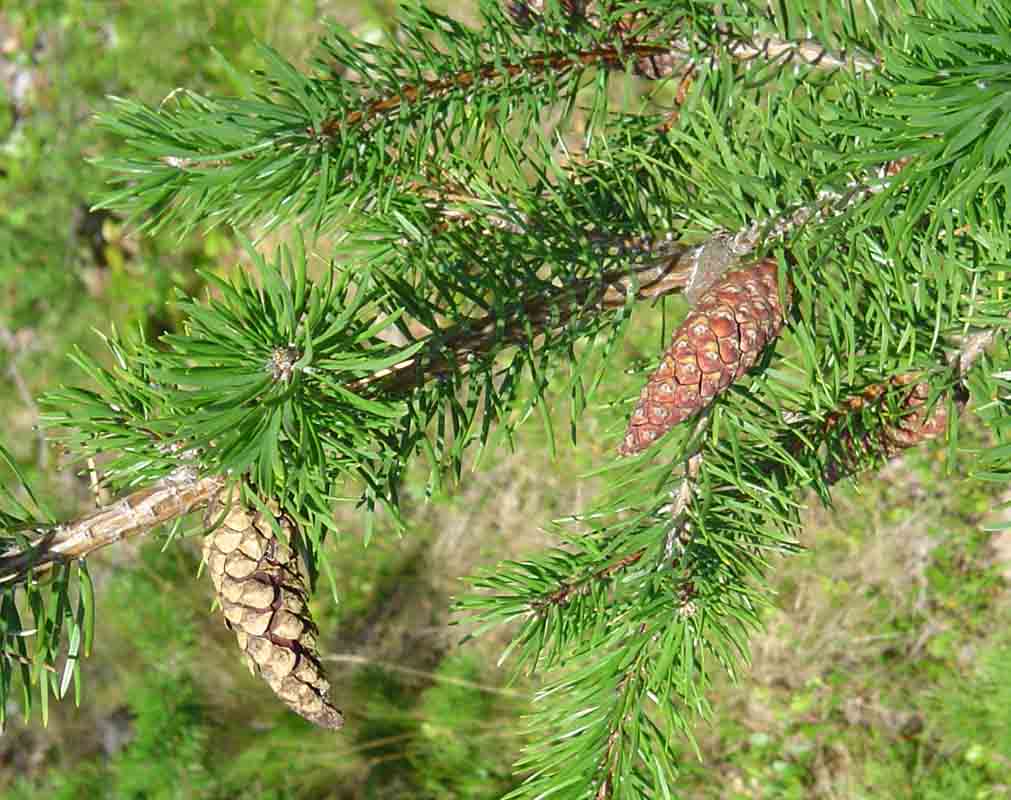
(click on image to enlarge)
Pinus nigra (Austrian pine) - [information to be added]
Pinus resinosa (red pine) is a species with fascicles of two long leaves. These leaves usually break cleanly when folded back against themselves (image at lower left). When the seed cones fall from the tree, they leave behind several scales on the tree, yielding what are called “hollow-based” cones. The bark (below middle) is not furrowed as is the bark of Pinus strobus (white pine). Overall, the trees branches have a bottle-brush look (lower right).
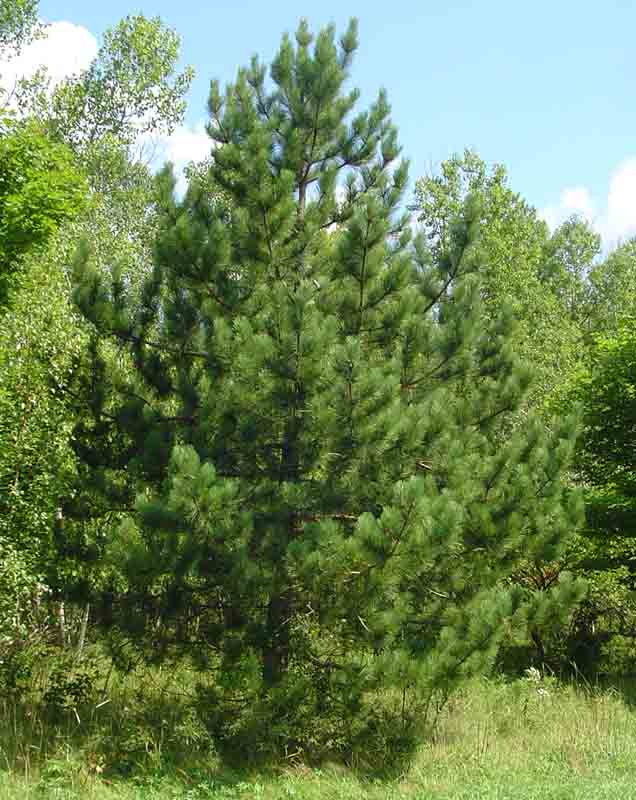
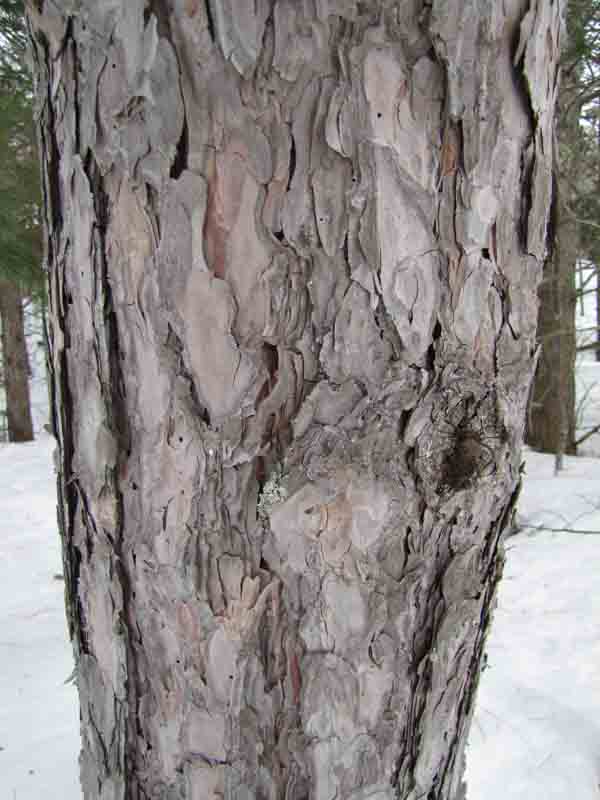
(click on an image to enlarge)
Pinus rigida (pitch pine), Maine's only species with fascicles of three leaves (image below left), is abundant along the left side of the park loop road where it overlooks Sand Beach. The thickened portion, called an umbo, of each cone scale bears a sharp prickle (image below left). As with other species of Pinus, the pollen cones are clustered (image below right), these releasing pollen.
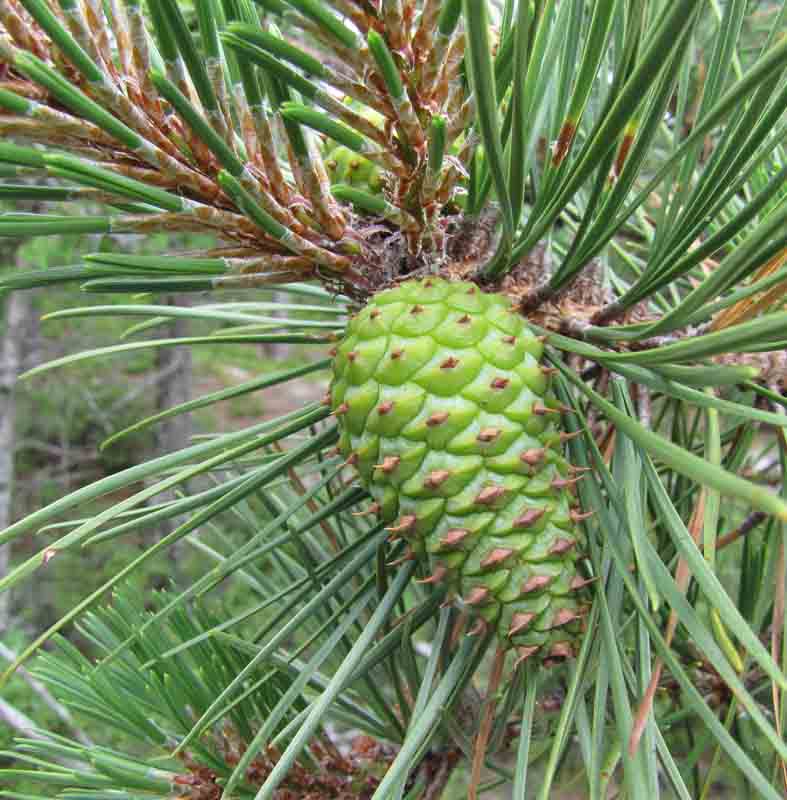
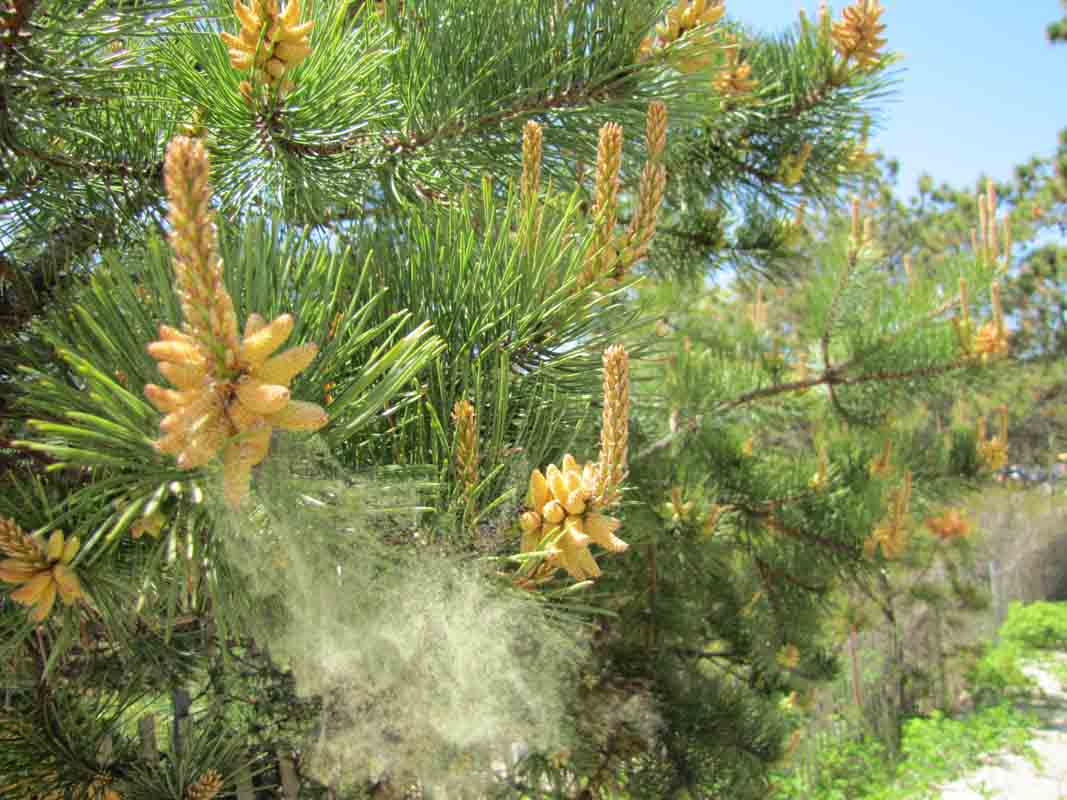
(click on an image to enlarge)
Pinus strobus (eastern white pine) is the most common species of pine in Maine and is Maine’s only species with fascicles of five leaves. A cross-section of a fascicle reveals five triangular needles that have bands of stomata (pores for gas exchange) on the two inner surfaces. A waxy substance makes these appear as pairs of whitish stripes in the photo. Eastern white pine has the longest seed cones in the genus in Maine. It is not unusual to see very straight trunks with their characteristic bark. The name Pinus strobus was given to this species by Carl Linnaeus in the first edition (1753) of his Species Plantarum, the beginning point for plant names as established by the International Code of Botanical Nomenclature.
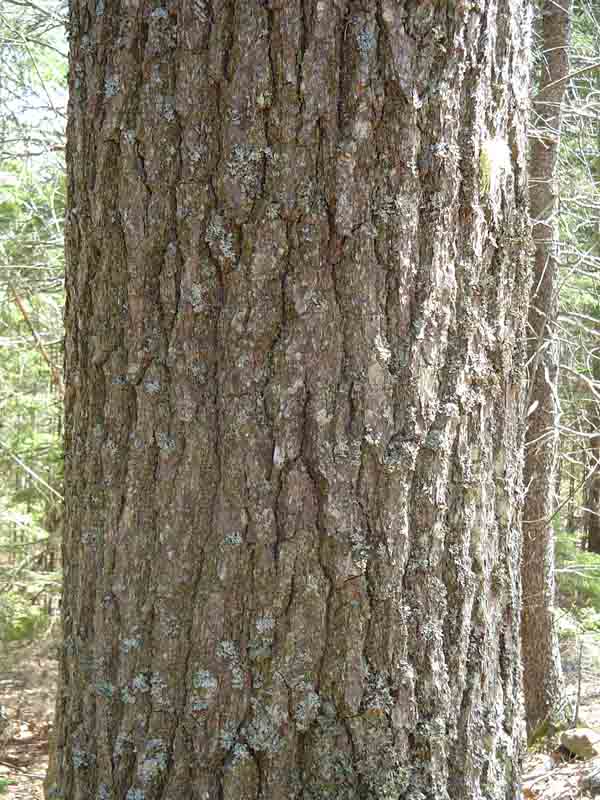
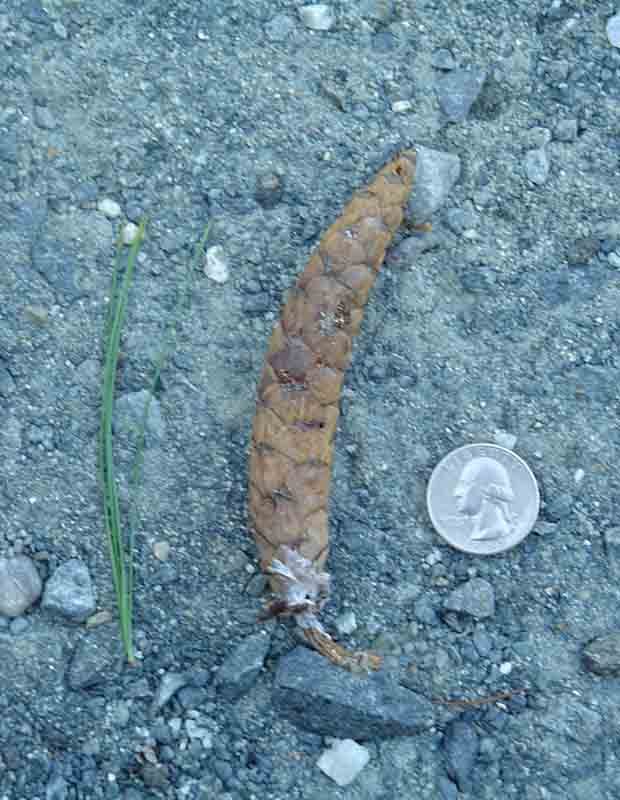

(click on an image to enlarge)
Pinus sylvestris (Scotch pine), like jack pine, has fascicles of two short leaves. Unlike the fairly straight leaves of jack pine, however, the needles of Scotch pine are somewhat to quite twisted (image below left). By far the most distinctive feature of this species is the orange-salmon color of the young bark (image below right).
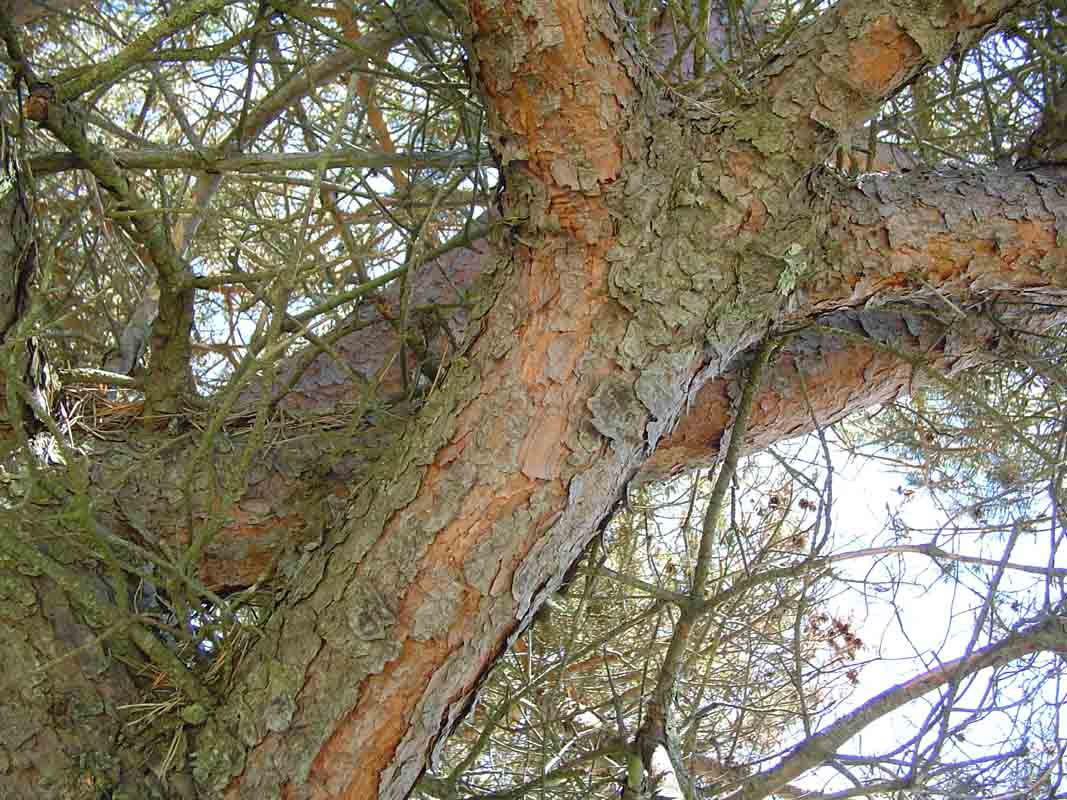
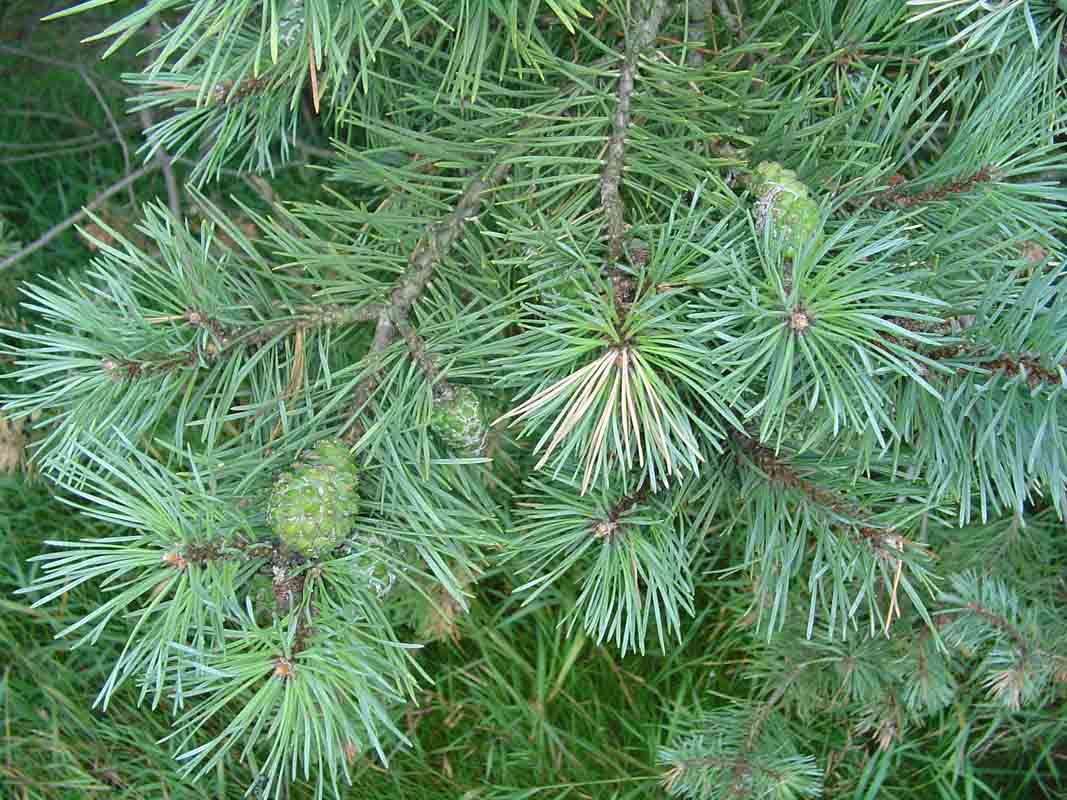
(click on an image to enlarge)
Tsuga (hemlock)
Of the 10 or so species of Tsuga worldwide, only one species is native to northeastern North America.
Tsuga canadensis (eastern hemlock). The abaxial (lower) surface of its leaves (image below left), like that of Abies balsamea leaves, is conspicuously white. A distinctive feature of T. canadensis is the presence of leaves laying lengthwise along the upper side of the twig (image below right). Note that when you look down at these leaves, you are looking at their abaxial surface.
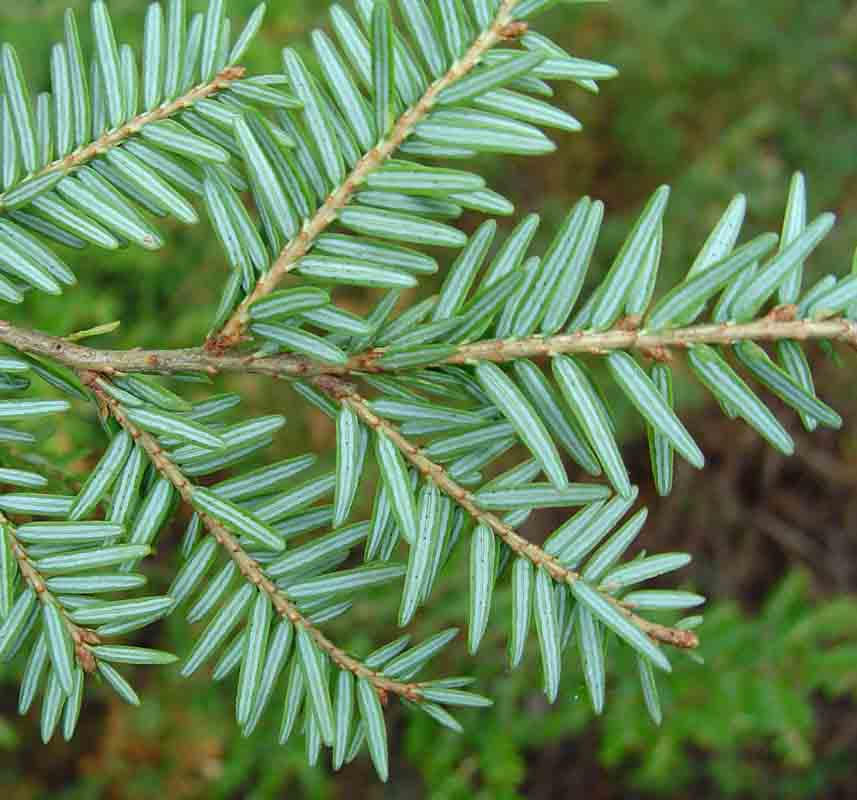
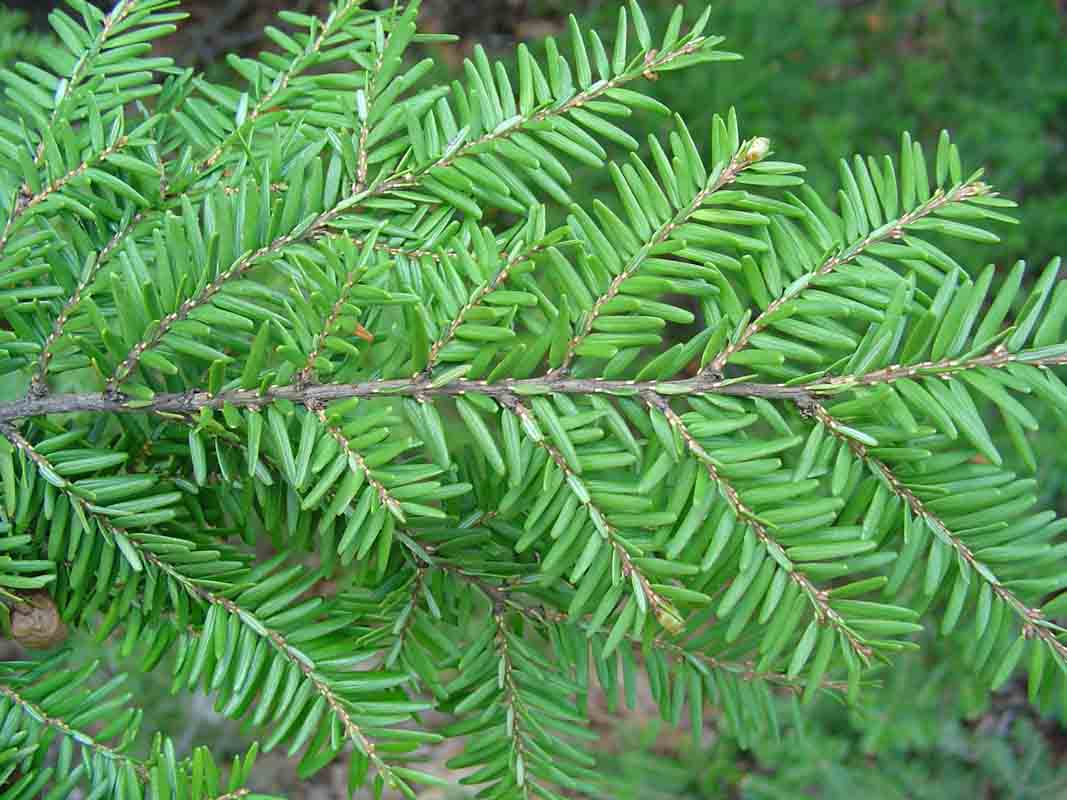
(click on an image to enlarge)
Note:
1. Taxonomy and nomenclature follow Flora Novae Angliae by Arthur Haines (2011, Yale University Press, ISBN 978-0-300-17154-9).